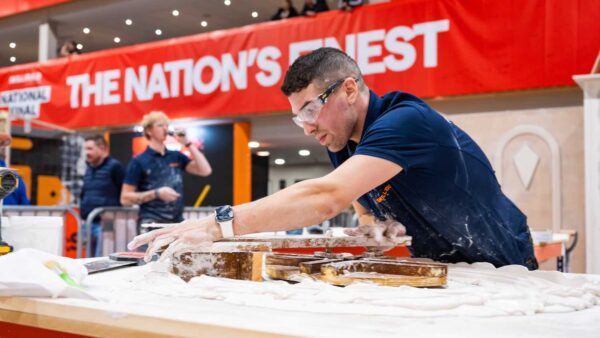People skills rarely feature in established routes to construction’s professional qualifications and it is from this gap that many industry problems arise. Performance coach Dave Stitt starts a new series on CM looking at where construction management often goes wrong – and how to fix it

I rose through the ranks in construction by being hard on everyone, including myself.
The behaviours I saw in my seniors, and learned to emulate myself, were aggression, assertiveness and dominance. I barked orders, tore strips off people and never backed down in a disagreement.
Once I saw “Dave Stitt is a bastard!” scrawled on the Portaloo wall, and it made me proud. Today, of course, I’d be mortified. That’s right, I’ve gone “soft”.
The change happened in the mid-1990s when I got involved in culture-change programmes at the companies I worked for, which culminated in me leading an award-winning, company-wide change programme at Wates.
“Construction’s management culture creates stress, stifles initiative and erodes engagement, which is very bad news for an industry that has a productivity problem and trouble attracting good talent”
Gradually, I saw that there was a better way to be that got better results and reflected the real me.
Since then, I’ve been spreading the message among executive boards and project leadership teams I coach, and they get it, too.
The industry’s default command-and-control management style, which barks orders, monitors compliance, and threatens blame and sanction for non-compliance, doesn’t work.
It creates stress, stifles initiative and erodes engagement, which is very bad news for an industry that has a productivity problem and trouble attracting good talent.
We’re a people industry, really
We tend to think of construction as a technical industry but it’s actually a people one, and I say that as a chartered civil engineer.
To execute a project, people from disparate organisations, often with competing agendas, come together to achieve a big result under pressure.
That’s a major challenge, and technical competencies are the starting point, but it takes people skills to knit them together.
Despite this, people skills barely feature in established routes to professional qualifications, so young leaders just soak up whatever ambient culture is there in the companies they work for, and the problem is perpetuated.
It’s from this gap, where those skills should be, that many of construction’s problems arise.
From command-and-control to coaching
There is a different way: a coaching style of management.
When they adopt basic coaching techniques, managers stop seeing their people as risks to manage and problems to fix, and they start seeing them as tremendous stores of talent and initiative to tap.
A coach knows people come to work to do a great job, that they want to do it, and they can do it.
But, as we all do, people face all sorts of barriers to achieving the results they want.
So a coach works with people to raise their awareness of the barriers they face, and encourages them to work out for themselves how they’re going to overcome those barriers.
This fosters engagement, excitement and initiative as people take control of their performance and grow in confidence and skill.
Construction’s problem is happiness, not image
Employee engagement in construction today is low.
We surveyed hundreds of construction professionals under the age of 40 and found that most of them – some 57% – would not recommend working in the industry to their peers.
They told us they want a more positive work environment, and to be supported by their managers to develop. That’s exactly what coaching does.
Since I can remember, we’ve wrung our hands over how to improve the image of construction to attract more talent. But what if we’ve got it the wrong way round?
Why are we worried about our image when its the nature of our management culture that is turning talent off?
And what if a better, more productive management culture made people happier? We’d then have many thousands of people saying what a great industry it is!
Young people listen to each other, not industry talking heads.
How we’re going to change things
After months of research and planning, we’re launching a new management course for young construction professionals delivered via the CIOB Academy, called ‘Coach for Results’.
It’s a 10-week course you fit around your schedule that teaches the basic coaching techniques to people in a leadership role, or heading for one, so they can enhance their management style for better results.
We’re sure it will benefit the industry, its productivity and its people.
In fact, we think it’ll change it from the ground up.
Dave Stitt is an executive coach at DSA Building Performance, specialising in construction.
Comments
Comments are closed.












Excellent article. In my professional career, I have tried to adopt the same principles and can vouch that it works. This was especially true when working overseas with a culturally different workforce. In the UK, with the increased diversity within the industry, those same cultural issues now exist here. Coaching is definitely the way to develop ones team. The old adage ‘treat others like you would like to be treated yourself ‘ is true in leading teams
I have been using this approach for over 50 years, that’s right 50 years. I always said Please and Thankyou to my staff before during and after completion of their allocated task. Further, I would never ask a person to carry out a task, that I had not done my-self, or have some one explain the task to the operative first. Graduates are good at being academic, but practical knowledge is also a huge bonus out on site. Put the two together and you have a good manager. Really pleased it has taken until 2021 to bring this to the attention of management. Maybe Carrillion would not have failed if the people at the top had, had construction hands on experience.
Where am I coming from, I started in the 1950;s as a carpenter on site, I worked through the usual promotional route and ended up as a member of the CIOB, RICS, A masters degree in construction management , as well as studying and controlling large scale foundation works.
I was lucky in my chief executives, all took the view that people were your most valuable resource , use them properly. This goes for subcontractors and suppliers, pay all accounts on time, pay what they are due, not a penny more, not a penny less!
As one put it “The mane that has not made a mistake has not been invented yet, just do not make the same one twice Do not set up a blame culture.
This did not mean we were an easy ride. we set the philosophy and everyone from the bottom up was expected to observe it.
It may sound a little fanciful, but it worked, you had a contented site producing good quality work
That’s the construction industry for you – people need coaching just to be reasonable!
Similar backgrounds working from the tools to Management positions.
100% agree Construction is a people business & how we motivate and encourage people to actually turn up and apply themselves to certain tasks and expect them to have pride in what they do is an uphill battle for the majority of Construction site Managers.
Unfortunately IT has taken the coaching aspect away as time taken staring at laptops and attending endless meetings about programmes that have drifted add stress to the Management and this goes down to the floor.
So yes let’s instruct the MDs , QS and the Client that it’s a people business and each and every one of those involved to encourage it helps to have a safe place to work.
Unrealistic construction programs don’t help so hands up get in the real world and be honest about the project no smoking mirrors which is common.
Site Management in my day as an Apprentice Carpenter they walked the site and talked to individuals involved the only time they went to the office was to read the newspaper.